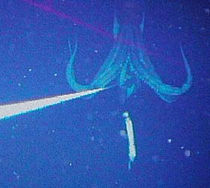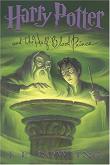

History will record this week as having ushered in a particularly fabulous crop of giant-squid news. A few days ago, we saw the first ever live video of a giant squid. And now comes another study in which Spanish scientists examined several giant squid washed ashore — and found that the males had been inseminated with sperm.
The explanation beggars the modesty of my otherwise PG-rated blog, but here we go: Apparently, male giant squid have these totally ginormous penises. They’re nearly as long as their arms, and they possess the intensity “of a fire hose,” as the scientists write. The squid evolved these massive members because female giant squid are about 1/3 bigger than the males, and they don’t much like being inseminated, so they tend to fight back. The sizeable length allows the male to have sex from a safe distance and get the hell outta Dodge before being eaten alive. This is all the trickier because mating takes place during enormous, multisquid orgies.
But the result is that squid sex is pretty violent, and mistakes can happen. As the scientists told The Scotsman:
It seems that co-ordinating eight legs, two feeding tentacles and a huge penis, whilst fending off an irate female, is a bit too much to ask, and one of the two males stranded on the Spanish coast had accidentally injected himself with sperm packages in the legs and body. And this does not seem to have been an isolated incident since two of the eight males that had stranded in the north-east Atlantic before had also accidentally inseminated themselves.
Even better, some of the males appear to have inseminated each other. That’s right: Gay giant-squid sex. Accidental gay giant-squid sex.
(Thanks to Brian Corcoran for this one!)

aaut
One of first truly famous pieces of machinima — that DIY art of using video-games to make animated movies — was “Warthog Jump”, a video in which Randy Glass placed explosives beneath Warthog vehicles in the game Halo and made them blow up real good: They’d pinwheel through the air, executing gorgeously synchronized pirouettes. Glass must have spent weeks practicing with grenades to figure out how many were needed to blow the jeeps in precisely the right directions. If you’ve never seen it, go check it out right now!
After you’re done, go check out a little Flash game I just saw called Warthog Launch. The game is based on Glass’ little video: You have to place grenades beneath a Warthog jeep, in the precise quantity and precise location so that they’ll fly up and destroy a bunch of aliens. It’s actually not a bad little puzzle game!
But more importantly, it’s a media tribute of nearly autoerotic dimensions: A game based on a comedy show that was itself based on a game. My head hurts. To add one yet one more layer, astute game historians will note that the gameplay in Warthog Launch is an updating of the 1970s ur-game, Cannonball.

A while back, I blogged about how board-game maker Greg Stolze had pioneered a cool new publishing paradigm — the “ransom model”. It works like this: Stolze describes a new concept he has for a board game, and sets a ransom price for it, like maybe $600. Anyone can donate money to meet that goal. Once the goal is met, he designs the game — and puts it up for anyone to download for free online. It’s a win-win solution: Game-lovers get a new game (with a great “pay what you can” pricing scheme), Stolze gets paid for his work, the larger public can get a free ride off those who are juiced enough to donate money, and piracy is instantly rendered irrelevant.
He’s done two successful ransoms in the past, but now he’s doing a charitable one: Executive Decision, a game for which the ransom is $1,000, all of which will go to the Red Cross for Hurricane Katrina relief. I particularly love the interplay of the charitable focus with the gameplay: Since Katrina was a disaster created almost entirely by governmental bungling and delay, Executive Decision is about precisely the opposite. As Stolze describes:
Executive Decision is a white-knuckle game of political decisionmaking and brinksmanship set in the Oval Office. Players take on the roles of the President and his top advisors, then plunge into the middle of a crisis demanding leadership.
Events in Executive Decision are resolved without recourse to dice, bidding, cards or other random elements: It all boils down to your ability to argue and persuade. The fate of the nation may rest in your hands… if you can only sway the Chief Executive with your words.
I love it. The ransom deadline is Nov. 5, and he’s raised 75% of the funds so far. If you want to throw him some money, here’s the link!

Okay, prepare for the sheerly weirdest piece of news to emerge from the Katrina tragedy: Sources say the hurricane accidentally set free a handful of top-secret bottlenose dolphins that are equipped with toxic darts and trained to stun terrorists.
No, I’m not making this up, nor indeed could I. The dolphins are part of the Navy’s “Cetacean Intelligence Mission”, which was founded in 1989. They’re outfitted with the darts, and are supposed to swim around Navy subs and keep them safe from terrorist attack by identifying any rogue frogmen and stunning them. Leo Sheridan, an accident specialist, told The Guardian he’d heard that the dolphins got loose during the hurricane, which raises the following specter:
“My concern is that they have learnt to shoot at divers in wetsuits who have simulated terrorists in exercises. If divers or windsurfers are mistaken for a spy or suicide bomber and if equipped with special harnesses carrying toxic darts, they could fire,” he said. “The darts are designed to put the target to sleep so they can be interrogated later, but what happens if the victim is not found for hours?”
Man, I would not want to be the surfer trying to catch some serious pipe when Flipper goes into 007 mode. Given the incredibly high intelligence of dolphins, I can imagine two scenarios here: i) The dolphins are wise enough to realize something is remiss, and they hold back on attacking anyone. ii) The dolphins are totally bored of serving their bipedal masters and revolt, in which case, as The Onion predicted a few years ago, we are screwed.
NOTE: According to Snopes, this is “probably” an urban legend. The Cetacean Intelligence Mission does indeed exist, but dolphins probably aren’t outfitted with toxic darts.
(Thanks to Debbie Chachra for this one!)

In this week’s New York Times Magazine, I wrote a story about the advent of high-performance hybrids — cars that are good on gas but also wildly muscular. One of the is the Enigma, pictured above! The piece is online at the Times site, and I’ve also permanently archived it here:
The High-Performance Hybrids
Can a car that goes from 0 to 60 in 4.3 seconds be good for the earth?
by Clive Thompson“Hold on to your hat!” Jim Burns shouted as he slammed the accelerator to the floor. With a high-pitched whine, the electric motor behind my seat burst into action, and “the Enigma” — an experimental red sports car in which I was riding shotgun — bolted forward, pressing me back into my leather seat. In about three seconds we were whipping through the San Diego State University campus at 50 miles an hour.
“We built her really low, so she totally hugs the ground,” Burns said as we coasted to a stop at a large intersection near Highway 8. “Watch this.” When the light turned green, he floored it again while yanking the steering wheel to the left so that in the middle of the intersection we performed two 360-degree doughnuts, complete with white smoke pouring off the shrieking back wheels. The nearby drivers stared. Giggling, Burns, a mechanical-engineering professor, straightened the wheel and roared out of the intersection; a stolen glance backward revealed that we had left a thick trail of burned rubber on the asphalt. We finally coasted to a halt near his campus laboratory, where a team of students was waiting with a video camera.
“Dude, that was awesome!” one of them blurted.

I am beside myself with excitement. After hundreds of years of hunting, scientists have finally caught the elusive giant squid — Architeuthis — live on camera.
How did they pull off this historic feat? Well, a Japanese team sent a robotic camera down to 3,000 feet, just off the Bonin Islands. They also sent down a hook baited with a fresh Japanese Common Squid, as well as a mesh bag filled with “freshly mashed euphausid shrimps” — mmmmmmmm — as an odor lure. Then after days of waiting, pay dirt: They felt an enormous tug, as a 26-foot-long giant squid grabbed hold.
And hey — you know all those supposedly crazy stories told by half-deranged sailors about giant squid attacking their boats? Maybe those aren’t so half-cocked after all, because Architeuthis turns out to be one hell of a brawler. It struggled for four solid hours to get free, alternately jetting away at full speed, then zooming back in an attempt to subdue the robot. As the New York Times reports:
The giant squid, the researchers conclude, “appears to be a much more active predator than previously suspected, using its elongate feeding tentacles to strike and tangle prey.” The tentacles could apparently coil into a ball, much as a python envelops its victims.
To truly fry your mind, check out the time-lapse-photography video of the squid in action posted at MSNBC. Keep in mind, while you’re looking at it, that the span of those tentacles is larger than most people’s front yards. Yiiiii! For additional fun, check out the paper written the scientists published today in The Proceedings of the Royal Society (PDF version here). The thing that cracks me up is that they actually don’t have a whole lot of data to report; the main thing, I gather, is that they get the totally cosmic street-cred of being able to write a paper with the title “First-ever observation of a live giant squid in the wild”.
I wonder if any other scientists will be able to copy this technique — and catch another one? On the other hand, it might not be a good idea to piss these things off too much.
(As regular blog readers can tell by the fact that I’ve not posted in a week, I’ve been positively slammed by work. So a huge shout-out goes to all the folks who emailed me to make sure I’d heard the news — including John Tinmouth, Andrew Griffin, Robin Sloan, Guillermito, Justin Yoshida, Tony Blow, Koutnik, Alexander Khost, Ian Daly, Peter Krekel, Rob Toole, Jeff MacIntyre, Joe Adiletta, Brian Corcoran, Lisa Fortin, Jonathan Korman, Andrew Rickard, Sam Feinson, and Bret Dawson!)

Dig this: An Ebola-like epidemic is raging in World of Warcraft, the enormously popular online game — and it’s killing players left and right. The trouble began when Blizzard, the company that runs World of Warcraft, introduced a new opponent called Hakkar, the “god of blood”. When you fight him, as a defense he infects you with something called “Corrupted Blood”, which shaves off your hit points so rapidly that your character dies very quickly. Problem is, the Blood is infectious — get close enough to another player and you’ll pass on the disease. As one player reports from inside the game:
The amazing thing is SOME PLAYERS have brought this disease (and it is a disease) back to the towns, outside of the instance. It starts spreading amongst the genral population including npcs, who can out generate the damage. Some servers have gotten so bad that you can’t go into the major cities without getting the plague (and anyone less than like level 50 nearly immediately die).
GM’s even tried quarantining players in certain areas, but the players kept escaping the quarentine and infect other players.
Over at the superb game-theory blog Terra Nova, one player notes that the disaster has taken on Katrina-like proportions, complete with a fumbling bureaucracy. Some players feel Blizzard’s executives didn’t read up on their network-theory carefully enough to predict how badly things would rage out of control:
Deaths on Suramar numbered in the hundreds, I personally have screenshots of skeletons piled waist high in parts of the auction house. The biggest disappointment wasn’t that it happened, but that Blizzard was so incapable when it came to dealing with it.
And the living shall envy the dead. Of course, this digital pandemic isn’t all that awful, insofar as when you die in World of Warcraft you can just reanimate yourself. But the stories from witnesses to the in-game carnage are pretty amazing, and it makes me wonder: Maybe we should be using online games to study the effects of a real-world bioterror attack? Maybe FEMA and the government should hire Blizzard to build them an online world, and populate it with players by offering it for free. They researchers can test the effects of a contagious bioterror attack such as smallpox — by releasing a virtual version of it, and seeing how players react.
(Thanks to Jacob for this one!)

In the Harry Potter universe, how precisely does one become a wizard? Well, if you’ve read the J. K. Rowling books, you’ll know that the world is divided into magical peoples — wizards and witches — and normal, unmagical ones, the muggles. A wizard or witch can be born from two magical parents, two muggles, or a mixture thereof — a half-blood.
This got a couple of genetic scientists in Britain wondering: What are the chromosonal implications here? They quickly set pen to paper and produced one of the more curious letters that has ever appeared in Nature: A Darwinian explanation of the Harry Potter’s inheritance of magical abilities. To quote:
This suggests that wizarding ability is inherited in a mendelian fashion, with the wizard allele (W) being recessive to the muggle allele (M). According to this hypothesis, all wizards and witches therefore have two copies of the wizard allele (WW). Harry’s friends Ron Weasley and Neville Longbottom and his arch-enemy Draco Malfoy are ‘pure-blood’ wizards: WW with WW ancestors for generations back. Harry’s friend Hermione is a powerful muggle-born witch (WW with WM parents). Their classmate Seamus is a half-blood wizard, the son of a witch and a muggle (WW with one WW and one WM parent). Harry (WW with WW parents) is not considered a pure-blood, as his mother was muggle-born.
There may even be examples of incomplete penetrance (Neville has poor wizarding skills) and possible mutations or questionable paternity: Filch, the caretaker, is a ‘squib’, someone born into a wizarding family but with no wizarding powers of their own.
Cool enough. But even better is that three other scientists immediately dashed off a following letter that disputed the theory. Noting that “Hermoine’s parents were muggle dentists who lack any family history of wizarding,” they find “the assumption that wizarding has a genetic basis to be deterministic and unsupported by available evidence.”
Finer tongue-in-cheek science cannot be had. Though they weren’t merely being witty. The original scientists wrote their Nature letter as a “teachable moment”: They noted that since genetics are difficult to teach to young children, Potter’s universe offered a unique opportunity for science teachers to talk about DNA and inheritance. But this also, of course, implies the teaching of evolution, which makes you wonder which will be the bigger reason for the evangelical right to hate J. K. Rowling: Because she’s indoctrinating kids in witchcraft — or in Darwinian science?
(Thanks to Samuel Arbesman for this one!)

This just in: A German scientist has recently been forced to clarify that contrary to press reports, he has not invented a method of turning dead cats into automobile fuel.
Ahem. Apparently, the confusion stems from a story that the German newspaper Bild Tuesday wrote about Christian Koch. Koch holds a patent on “KDV 500”, a technique that can turn waste — such as paper, textiles, and plastic — into crude oil. So Bild Tuesday published the following:
Bild Tuesday wrote a headline: “German inventor can turn cats into fuel — for a tank he needs 20 cats.” The paper on Wednesday followed up with a story entitled: “Can you really make fuel out of cats?” [snip]
“I drive my normal diesel-powered car with this mixture,” Koch is quoted saying in Bild, next to a large picture of a kitten. “I have gone 170,000 km (106,000 miles) without a problem.”
There’s a saying we have in journalism: Too good to check. This means “the story is so incredibly weird and amazing that I don’t want to check it, because if I find out it’s not true, I won’t be able to write it.” Well, the dead-cat story was clearly way too good to check, such that typing “dead cats fuel” into Google News — really the best search query ever — shows that dozens of newspapers picked up this story and ran with it, ranging from CNN to the People’s Daily Online. The upshot is that the poor scientist spent last week frantically sending out press releases denying that he was grinding kitties’ bones to make his bread … which of course resulted in an even more surreal slew of headlines, such as “Inventor Denies Dead Cat Fuel Ingredient”.
Meow.

In any natural disaster — or massive terrorist attack, like 9/11 — the phone system tends to collapse. Isn’t there any backup way to keep talking? Sure: Wifi meshes, as I argue in an essay that appeared this Sunday in the New York Times Magazine. The story is online here, and a full archived copy is below:
Talking in the Dark
by Clive ThompsonWhen was the last time you heard a “busy tone” on a telephone? Probably not for years. Our phone system is so robust, our mobile phones are so ubiquitous and voice mail and e-mail are such reliable backups that instant, unhindered access to friends, colleagues and relatives has come to seem a right and not a privilege. Indeed, if you include instant-messaging, blogs and cellphone text messages, you might think we’re living in the golden age of communications.
Except when disaster hits. Two weeks ago, I tried calling a colleague down in New Orleans — and found myself listening to the annoying honk of a busy signal and the static of a dead phone line. Katrina had disrupted the city’s communications grid, and residents and emergency responders were grappling with the chaos that ensued. For a week, just about the only people with communications were those government officials and reporters lucky enough to have two-way radios or satellite phones with adequately charged batteries. Everyone else staggered around in blind ignorance — which helped produce horrifying pandemonium. We saw a similar lesson in 9/11: When communications crumble, so does society.

Here’s a really lovely piece of journalism: Paul and Michael Albert, a writing-and-photography team, went kayaking in the sea of Cortez to witness an enormous school of mobulidae breaching the surface — and leaping into the air like dolphins. Mobulidae, a family that includes both manta rays and mobulas, grow several feet in width, so their aerial leaps were pretty stunning:
Whoosh! Without warning, a mobula emerges from below the surface, its long flat body glistening in the evening light and whip for a tail trailing behind. Flap, flap, flap, maybe a somersault or two, and then smack! It happened again and again. Single flips. Straight-up belly flops. Double flips. I see a single mobula leap a few times in succession; others leap only once and then disappear. I witness mobulas partially emerging from the water, one third of the wingtip still immersed, and rotate around that tip. Sometimes, I don’t even see that. All that is visible is the swirl of water left behind. Notarbartolo di Sciara writes that when he was in the Sea of Cortez some twenty years ago, he even observed triple flips. According to him, some mobulas leap at heights of up to two times their disc width or up to six feet high.
Why precisely do mobulas jump out of the water? No-one’s sure, but as the Alberts note, some scientists speculate that the jumps could be accidental — artifacts of the creatures’ feeding patterns, which involve swimming tight circles around their prey. Swim too close to the surface, and boom: Ya wind up in the air. Others suggest that it could be to dislodge other sea creatures that attach to their bodies. Perhaps most intriguing is the speculation that maybe it’s just play — because mobulas have extremely large brains for their bodies, and the ratio is nearly that of most mammals.
(Thanks to Boing Boing for this one!)
Slate runs a column called “The Explainer”, which picks an interesting question every few days and offers a quick, succint answer. This week’s question noted the preponderance of pictures of floating dead bodies in New Orleans, and asked: “Why are bodies in the water always facedown?” Because of some quirks of anatomy, chemistry and physics, as it turns out:
A cadaver in the water starts to sink as soon as the air in its lungs is replaced with water. Once submerged, the body stays underwater until the bacteria in the gut and chest cavity produce enough gas — methane, hydrogen sulfide, and carbon dioxide — to float it to the surface like a balloon. (The buildup of methane, hydrogen sulfide, and other gases can take days or weeks, depending on a number of factors.) At first, not all parts of the body inflate the same amount: The torso, which contains the most bacteria, bloats more than the head and limbs. The most buoyant body parts rise first, leaving the head and limbs to drag behind the chest and abdomen. Since arms, legs, and the head can only drape forward from the body, corpses tend to rotate such that the torso floats facedown, with arms and legs hanging beneath it.
That is both extremely interesting and thoroughly disgusting. Though it’s a pale shadow of the following paragraph in that “Explainer”, which discusses “refloats” — a concept of sufficient grotesquerie that I’m totally not going to excerpt it. Click and read it yourself, assuming you’ve already eaten lunch.

In our fast-moving, email-pinging, mobile-phone-ringing world, privacy is a hard thing to come by. For those times when you desperately need to shut the world out, hie thee to an Ocula — the ultimate in personal-boundaries technology! As the Hammacher Schlemmer catalogue describes it:
This private relaxation theater is handmade of fiberglass and integrates advanced audio, visual, seating, and environment technologies, as well as your choice of Macintosh or PC computer, to create a space that allows you to relax completely. The Oculas has an electronic door that closes silently at a touch, coccooning a sitter inside the well-lit interior, which is upholste red with leather seating for comfort and completely ventilated for continual airflow that prevents stale air without compromising external noise reduction. An electronic controller allows the user to adjust the light through a complete spectrum of hues and brightness levels for optimal reading, video-watching, or relaxation and sleeping.
Only $45,000 apiece, earthlings. The mind boggles at the potential applications. Rather than have cubicles at work, wouldn’t it rock to have your office filled with these things? Then every morning everyone shows up, says hello, grabs a coffee — and seals themselves into an egg. Your company would look like one of the breeding-ground scenes from Alien. And man, I think about some of the programmers I know … if you could instal some sort of built-in bathroom technology and a feeding-tube apparatus, hell, they’d sit there coding and wouldn’t come out for a week.
(Thanks to the Book of Joe for this one!)

For my latest Wired video-game column, I wrote about a new booming cottage industry: Novels based on popular games. To quote:
Here are some details about Sam Fisher you probably didn’t know: He’s 47 years old, and his hottie martial-arts instructor has a major crush on him. He lives alone in a condo and struggles to figure out how to deal with his college-age daughter. His favorite pastime is gourmet cooking. He thinks the Iraq war is a bad idea.
Sam Fisher is, of course, the hero of the Splinter Cell video game. I’ve spent countless hours using my Xbox controller to sneak him past armed guards, scale walls and club enemies unconscious. But I didn’t know much about his personal life until I wandered into an airport bookstore recently and encountered Splinter Cell — the novel.
You can read the rest of the piece online here for free!

Who knew? Apparently, the superb documentary March of the Penguins has become a hit amongst creationists. Why? Because they think — as the Science section of the New York Times reports today — that the sheer tenacity of the penguins, and their ability to thrive in a hostile environment, points inexorably to the hand of God. As Andrew Coffin writes in his film review at World Magazine:
That any one of these eggs survives is a remarkable feat — and, some might suppose, a strong case for intelligent design. It’s sad that acknowledgment of a creator is absent in the examination of such strange and wonderful animals. But it’s also a gap easily filled by family discussion after the film. Talk of evolution is minimal, as is much scientific discussion of onscreen events, with Mr. Freeman’s narration focused more on the poetic than Discovery Channel — style details.
It’s a pitch-perfect example of the surreal tautologies that creationists use to explain away evolution: If something appears to have been designed, then it clearly must have been. It reminds me also of something a friend once said: That people who believe intensely in Providence, karma, or the hand of God in everyday affairs, are creepily similar to schizophrenics who believe that they can spot meaningful patterns in the white noise of daily life. (“Four traffic lights in a row all turned red just as I approached! I’m being warned not to complete my journey!”)
One of the great gifts of science is that it helps us break through how reality appears to work, and lets us figure out how it actually does work. But Coffin would rather explore the workings of the universe via “family discusssion” than, oh, reading about the actual work of real scientists who carefully test their theories to make sure they fit the facts.

About ten years ago I was in a Toronto bookshop and found a copy of Infiltration. Subtitled “the zine about going places you’re not supposed to go”, it was devoted to the escapades of the author, Jeff Chapman — or “Ninjalicious”, to use his nom de plume — as he explored the many off-limits areas in famous Toronto buildings such as the Royal York hotel, CN Tower, or St. Mike’s Hospital. In each issue, Chapman would pick a new target and infiltrate it — roaming curiously around, finding hilarious secrets, then describing it with effervescently witty delight. Chapman had the best prose of any zine author I’ve read anywhere. Many zinesters are clever, of course, but Chapman wrote with a 19th-century literary journalist’s attention to detail; nothing escaped his notice, from the relative fluffiness of the towels in executive lounges to the color of the rust pools in a mysterious, hangar-sized room buried below Toronto’s subway system.
It was like some postmodern version of Fodor’s. Indeed, that was Chapman’s genius: He approached the everyday world as if were filled with Narnia-like ‘ports to hidden worlds of mystery. As he realized, when you walk down the sidewalk in your city, there are rooms and places barely twenty feet to your right and left that are so restricted — being “private” areas of corporations, or even of public buildings — that they are effectively as remote as an island in Fiji. To travel to them is like voyaging to the summit of Mount Everest. And of course, in the 15 years since he started the zine, private companies have taken over more and more formerly public space — making Chapman’s quest not only funny and engaging but somewhat political.
A few years after he started publishing, he’d inspired so many other people to follow in his footsteps — in cities around the world — that he had singlehandedly created the “urban exploration” movement. Though urban exploration involves trespassing, Chapman took the same attitude towards it that the Boy Scouts take towards the wilderness, as Eye Magazine wrote about him last week:
He was evangelical about the virtue and value of exploring cities, preaching ethics that encouraged trespassing but forbade theft, vandalism and even littering. Urban explorers in the Ninjalicious mould believed in leaving no sign of their tourism through the inner workings of urban life, and in taking nothing with them but photographs and a new appreciation for the world around them.
He also founded a web site for urban exploration, and documented his ongoing journeys not only in the zine but in gorgeous color pictures on his blog. A couple of my favorite recent entries: The snow-covered roof of Toronto’s new art-college building; the enormous rooms under construction at the Eaton Center; and massive, corroded bins left behind in the abandoned Stelco factory.
Sadly, the reason Eye and I are writing about Chapman in the past tense is that he died of cancer last month — and he was only 31. He’d apparently been struggling with cancer for years, and it was during his treatments at St. Mike’s hospital in the early 90s that he became intrigued by the hidden areas in a supposedly public building.
Then he was off and running and thankfully never stopped. The world could use more brilliant obsessives like him.

Here’s a brilliant bit of engineering: A straw that purifies water as you sip through it — allowing people to drink directly from rivers and lakes that are otherwise fatally ridden with bacteria. A creation of Vestergaard Frandsen, a firm that specializes in “disease control textiles”, the LifeStraw is aimed squarely at developing worlds plagued by bacteria such as Salmonella, Shigella, Enterococcus and Staphylococcus.
How precisely does it kill those bugs? As medGadget reports:
What first meets the water when sucked up is a pre-filter of PE filter textile with a mesh opening of 100 micron, shortly followed by a second textile filter in polyester with a mesh opening of 15 micron. In this way all big articles are filtered out, even clusters of bacteria are removed. Then the water is led into a chamber of iodine impregnated beads, where bacteria, viruses and parasites are killed. The second chamber is a void space, where the iodine being washed off the beads can maintain their killing effect. The last chamber consists of granulated active carbon, which role is to take the main part of the bad smell of iodine, and to take the parasites that have not been taken by the pre-filter or killed by the iodine. The biggest parasites will be taken by the pre-filter, the weakest will be killed by the iodine, and the medium range parasites will be picked up by the active carbon. The main interest to everyone is the killing of bacteria, and here our laboratory reading tells us that we have a log. 7 to log 8 kill of most bacteria. This is better than tap water in many developed countries.
That simply rocks.
(Thanks to Engadget for this one!)

What do you do with the rest of your life after you’ve been to the moon? This is the intriguing central question in Moondust, a book that tracks the later lives of the Apollo spacemen — and which the The New York Times asked me to review. It was published today, and the review is online here; I’m also archived a permanent copy below!
Down to Earth
by Clive ThompsonAlan Bean rode the Apollo 12 mission all the way to the moon, and on the way back he made a promise to himself: “I’m going to live my life the way I want to.” So he resigned from NASA, holed up in a tiny condo and became an oil painter. In the decades since, the only thing he has ever painted has been scenes from his celestial journey: the hyperreal sheen of sunlight on a space helmet, the lunar orbiter slicing through the void. Physically, Bean was back on earth — but some part of him clearly never came home.
Can you blame him? Only 12 people in history have ever stood on the moon. They were treated like heroes upon departure, rock stars upon return; they’ve even been credited with helping end the cold war. NASA spent billions to give them the biggest rush any explorer has ever felt. So you can begin to appreciate the peculiarly cosmic dimensions of their eventual midlife crises: after you’ve been to the moon, whatever do you do with the rest of your life?

Back in 1999, the Harvard neuroscientist Garrett B. Stanley decided to see if he could capture the actual brain activity showing what someone was looking at. So he took cats — which have very sharp vision — and tapped into 177 cells in their lateral geniculate nuclei, a part of the brain that integrates sensory input. Then he reconstructed the signals into approximations of what the cats were actually looking at. The results, excerpted above, were eerily precise: The pictures on the top are camera captures of the direction the cats were looking, and the images below are the reconstructions. Nutty, eh? (A PDF of the paper is here.)
So yes, William Gibson, it apparently is possible to jack into someone’s wetware and experience the world from their perspective. Chris McKinstry, a theoretical physicist in Chile, recently blogged about this experiment and said a) that it hasn’t been written about enough, and b) that it’s insanely important:
Now, we know what raw experience looks like inside the brain of another being, and thus entire philosophies of mind that were premised on internal experience forever being private, have been rendered obsolete.
I’m not so sure. This research is supercool, but merely knowing what someone’s visual system is imbibing is a far pass from knowing what they’re actually perceiving — since, as psychologists and philosophers have long realized, two people can look at the same thing yet notice or infer entirely different things, depending on their pre-existing frames of reference and biases. Me, I look at a couple of children sitting on cots in the Houston Astrodome after Hurricane Katrina destroyed their homes and killed their friends and family, and what do I see? Grief and shock. Tom Delay looks at them and what does he see? A couple of kids having a ton of “fun.”
Man, I’d love to know what’s going on in his lateral geniculate nucleus.
(Thanks to El Rey for this one!)

I’ve blogged many times before about El Rey, my artist friend who produces — among other things — the Surly Squid line of paintings, one of which hangs in my office. Well, if you know El Rey’s work, it tends to revolve around several icons: Squid, coffee cups, robots, pigs, monkeys wearing crowns. Today, I discovered that the web designer Ryan Masuga took all of these icons and produced El Rey Invaders, possibly the most mind-blowing Space Invaders port in history.
And: It’s hard! The current high score is 42,672,000, but I got a mere 17,450,000. This despite the fact that I was actually reaching back into my early-80s arcade toolkit and employing l33t Space Invaders strategy: Clearing the board down to a pack of four slow-moving aliens, at which point you wait for the super-bonus top-of-the-screen ships to repeatedly spawn and pick ‘em off.

Back in the 1980s, Stephen Wolfram began experimenting with cellular automata — little rule-sets that govern the “growth” of a collection of dots on an infinitely-sized grid. He’d pick a simple rule, set down a single dot, and then watch to see what sort of colony grew out of it. He expected each rule to produce a simple, repeated pattern — and was surprised when some of the rulesets produced seemingly chaotic, unpredictable shapes. Simple rules, it seems, can produce very complex results, an epiphany that Wolfram spun out into his masterwork A New Kind of Science.
Now he’s turned his automata into something really trippy: Music. He takes a vertical slice of one of his enormous automata grids, lays it horizontal, and uses it as a musical score, with each filled-in cell representing a tone. He calls it WolframTones — man, can anyone create a trademarked name these days that doesn’t include a gratituous internal capitalization? — and intriguingly, the resulting music is strangely tuneful. This, Wolfram says, is because …
… in the computational universe it’s easy to find rules that make complex forms. And that’s how WolframTones manages to create so many different complex musical compositions. Each composition in a sense tells in music the story of some system in the computational universe. And because the system follows a definite consistent rule, the compositions inevitably have a certain internal consistency — which is probably what makes them so effective as music.
Check out that page and you can hear an example. Then you can go to this page where Wolfram’s team has set up a little generator: Pick a musical style — from classical to rock/pop to latin — and it generates an automata, dumps it into the template, and plays the tune. If you like what you’ve done, you can even turn it into a ringtone, which is just the most brilliant thing evah. Let your phone ring with math!
(Thanks to Boing Boing for this one!)

For a few years now, I’ve been arguing that iPods are a weird sort of snob technology. By which I mean: People use them mostly not to fulfil a utilitarian function — i.e. to play music — but rather to broadcast a message that they are true music aficionados. To walk around with the aery white earbuds jammed in your skull is to insist that you are the sort of person who not only needs to have music around you — but needs to have 10,000 songs at your beck and call every second of the day, because nothing less would satisfy the subtle nuances of your all-encompassing taste: Cutting-edge German techno? Early Lomax folk blues recordings? Mozart? Your soul is on permanent shuffle. Mere labels cannot define you.
In reality, I’ve always suspected that iPod users are nowhere near so sophisticated. The average user of an iPod — or any of those other 4,000-gig players that can hold the entire Library of Congress — do not, I’ve claimed, listen to a wide range of music. No, they probably do what most people do: Plop on the Avril Lavigne for three months at a time on infinite repeat, until they get sick of it and move on to Usher. There’s nothing wrong with listening to music in this obsessive fashion; indeed, one of the joys of pop music is getting addicted to a single album and massively overdosing on it for weeks on end. But what cracks me up about the iPod is the fetishization of size — the insistence that you’ve got a simply massive record collection crammed in there. Indeed, so devoted are iPod owners to this cultivation of appearance that they’ve refused to replace the white earbuds with anonymous black ones, even when police recently began warning people that muggers were explicitly targetting the white ones. They’d rather risk having their iPod stolen than miss a chance to impress the proles.
The thing is, I’ve never really had any proof for my thesis. I’ve pretty much been pulling this one outta my hat.
That all changed today, when I read about a fascinating study done by wonks at the Solutions Research Group, a market-research firm. They polled 1,062 owners of digital-music players and asked them how many songs they have on their device.
The average? A mere 375 tunes. That’s right — despite regularly buying players that top out at 60 or even 80 gigs, with room for 20,000 songs, people are barely using a tiny sliver of their capacity. A PDF of the report is online here, and to quote it:
Despite a relatively high average of 375 songs per player, 50% of digital music players hold fewer than 100 songs — suggesting a perfect target for limited capacity mobile phone/digital music hybrids. A quarter of digital music players have 100-499 songs, while the remaining 25% have more than 500 songs.
Interesting, eh? I should point out that I am an enormous hypocrite for making this argument, because when the battery in my wife’s 10 gig iPod died last year and she upgraded to a new model, I took over her old one and used it for a few months. To layer on even more hypocrisy, she recently bought me an iPod Shuffle, which I’ve been using enthusiastically while travelling.
Though come to think of it, how many songs do I actually have on my Shuffle right now?
Hmmm. 145.
Right down there — with everyone else.

The New York Times Book Review asked me to review The Man Behind the Microchip, a new biography of Robert Noyce, the guy who invented the integrated circuit and founded Intel. It turned out to be an interesting opportunity to meditate on the nature of fame and inventors! The piece is available on the Times’ web site, and I’ve archived a complete copy below:
The Next Small Thing
by Clive Thompson“If nearly any invention is examined closely enough, it almost immediately becomes apparent that the innovation was not the product of a single mind, even if it is attributed to one,” Leslie Berlin writes. “Invention is best understood as a team effort.”
Right. In America, we’re conditioned to valorize the individual genius. To some extent we owe this caricature to biographies of famous inventors, because they play to the lone-gunman theory of brilliance. But many increasingly complex pieces of high-tech engineering — the Apple computer, the mobile phone, the Web browser — were the collaborative products of large teams, each person doing a small piece of work: less “eureka” than barn-raising.

Okay, so — the Seattle aquarium had a couple of Giant Pacific Octopi, and for logistical reasons they had to temporarily put one of them in a tank holding several sharks. They figured the octopus would be okay because it can change color to conceal itself from predators. But over the next week, the marine scientists came into work to find sharks are lying dead on the floor of the aquarium. Whatever was going on? They stayed around one evening and trained a camera on the water to see.
The result? Behold live footage of an octopus kicking the living crap out of a shark. It’s just mind-blowing: First, it skulks in the rocks, waits for the shark to swim by — then jumps up, wraps its tentacles around, and totally wails on the fish. I mean, seriously, that shark got 0wned.
Man. When the cephalopods finally rise up? We are so not ready.
(Thanks to Majikthise for this one!)
No, that’s not a typo. Over at her excellent Majikthese blog, Lindsay Beyerstein posted a piece of cephalopod spam she recently received:
Subject: Dried Squid Shred
Date: August 30, 2005 10:04:59 PM EDT
To: [Majikthise]Dear Sirs,
We know your esteemed company from the web side. We would like to introduce us as one of the major exporters of seafood and Dried Fruits in China.and we have been in this business for over 8 years. We are very glad to take this opportunity to establish business with you. At present,we can supply you:
1> Dried Squid Shred,Yellow Stripe Trevally,Dried Anchovy,Dried Squid Ring, Horse Mackerel, Dried Octopus Piece
2> Dried Pear Halves;Apple Rings Dried red Small Chillis
We shall be very glad to give you our lowest quotations upon receipt of your detailed requirements.

Moving right along from the weighty (the post below) to the trivial (this post), allow me to publicly drool over the iMPAMP — the world’s smallest all-tube stereo amplifier. Ever wonder why the sound coming out of an iPod kinda sucks? It’s not merely due to the much-maligned lossy compression of MP3s. Another big problem is that iPods — indeed, all small handheld audio players — have really cheap amplification circuitry. To get a really nice fat signal, you need a powerful amp, and ideally an analog one that uses vacuum tubes.
Ah, but how can you fit an entire tube amplifier in your man-purse? By getting a $545 iMPAMP, that’s how! As the creator boasts on his web site:
Perfect for your office or recording environment…you can put the iMP AMP right on your desk with bookshelf speakers and have a mini tube hi-fi setup for your iPod!
Check out his video introduction to this thing. It’s just insanely cute.
(Thanks to Andrew Hearst for this one!)

There’s been plenty of superb blogging about the Hurricane Katrina disaster, but my all-time favorite so far is a rather unexpected one: A post today by writer John Scalzi entitled “Being Poor”. It does not actually mention Katrina or New Orleans directly. It’s simply a list of symptoms of what it’s like being poor, including:
Being poor is knowing exactly how much everything costs.
Being poor is thinking $8 an hour is a really good deal.
Being poor is Goodwill underwear.
Being poor is making lunch for your kid when a cockroach skitters over the bread, and you looking over to see if your kid saw.
Being poor is relying on people who don’t give a damn about you.
Being poor is not taking the job because you can’t find someone you trust to watch your kids.
These are politically — and poetically — spot-on descriptions, and they go worlds to explaining why New Orleans has become such a total disaster. It’s not that the overwhelmingly poverty-stricken black population there didn’t know things were dangerous; they weren’t blithering idiots who chose to hang around while Katrina vaporized their houses. They simply couldn’t afford the cost of evacuating. One MSNBC reporter last night told of people who lived “check to check” and — being a few days shy of the next welfare check on Sept. 1, were entirely tapped out — wandered around begging for $20 to buy a tank of gas.
So this got me wondering about a political question. How will the American right wing — particularly congressional Republicans — respond to the screamingly obvious role of black poverty in this disaster?
For years, of course, Republicans have refused to admit that the cycle of poverty exists, or indeed that one’s economic conditions at birth could have any bearing on how you turn out later in life. But New Orleans has tossed a wrench into this idelogical perpetual-motion machine and stopped it dead. Pretty much every news organ — even Fox News — has been forced to point out the many ways the federal government left the poor of New Orleans out to dry. The Bush administration diverted money from levee maintenance and gutted FEMA; refused to accept aid that Chicago offered on Sunday; and, in a fascinatingly honest admission of their nearly psychopathic break with reality, explained on Thursday that they had only just learned of the rapes, assaults and bedlam in the New Orleans convention center — despite three days’ worth of incessant TV coverage thereof.
Given the awesome scale of deaths down in Louisiana, the defenders of the administration are in a tight corner. They need to appear to be deeply sympathetic to the tragedy, while also exculpating Bush and his people from any blame. What herculean political argument could accomplish these seemingly contradictory goals?
A hint came from Tucker Carlson last night. First, during an interview with Al Sharpton, he admitted candidly that the denizens of New Orleans were screwed because they were poor and couldn’t afford to evacuate. But then he hotly denied that this had anything to do with their being black. And then he made a heartfelt speech to the camera in which he said that history has always shown that the biggest victims of any natural disaster were — wait for it — poor children and the elderly. Those victims; those defenseless, uncomprehending and deeply vulnerable souls; those were the ones we ought properly to feel sorry for.
Well, fair enough. Children and the elderly are indeed the most physically weak, and they’ve died by the horrifying hundreds, probably thousands. But so has everyone else up and down the age demographic. Why single out children and the elderly?
Because this leaves some wiggle room to blame the adults — all the other black folks who implicitly are blundering idiots devoid of moral clarity and, if they’d just clean up their damn acts and get a job, could have saved themselves. Worse, by not boldly taking action, these moral failures put their children and elderly parents at danger!
I’m exaggerating for effect. Carlson, of course, did not openly connect those last few dots. But the strangely constrained dimensions of his sympathy reminded me of a superb article that appeared in the New Yorker about ten years ago. The article — I can’t remember or correctly Google the title or author, I’m afraid — surveyed the large number of early-90s documentaries devoted to black poverty in America, such as Hoop Dreams. The author noted that the documentaries were being hailed, quite rightly, as nuanced, incisive studies of poor America, and a breath of crisp realism after the loopy welfare-queen propaganda of the Reagan years.
Yet when the author scrutinized the documentaries more closely, he (she? Damn, I can’t remember) noticed that they all picked children and teenagers as their focus. Adults drifted in and out of the docs, but only peripherally; and when they were onscreen they were posed in unflattering lights, focusing on their “poor choices” in life and irresponsible behavior towards their kids.
This, the New Yorker author argued, is the weird blind spot that perenially prevents America from understanding the nature of poverty. We preserve enormous compassion for kids living in desperate straits — because we know they can’t be blamed for where they’re born. But once they turn 18 and become adults? You’re author of your own fate, and if you remain poor it’s because, dude, you suck. For poor children, we have bleeding hearts; for poor adults, we have three-strikes legislation and prim, pursed lips.
That’s why I was so fascinated by Carlson’s performance last night. Consciously or unconsciously, he perfectly intuited this slender path through the moral forest — and ran for it.
So here’s my prediction. Defenders of the administration need to accomplish three things: They must exonerate the administration from any blame for bungling the tragedy, shift the blame to the actual poverty-stricken residents, and yet somehow also appear sympathetic about the horrible suffering. The most elegant way to do this is to bemoan the plight of New Orleans’ children and elderly — and imply, or perhaps sneeringly state outright, that everyone else in the Lower Ninth Ward of New Orleans is at fault for not protecting their vulnerable dependents, and themselves. It’s the only way for a pundit or politician to avoid looking like a sadistic cretin while remaining, in fact, a sadistic cretin. I’ll be watching the TV and newspapers for signs that this line of argument has slithered into the national debate.
Which brings me to my single-favorite line in Scalzi’s analysis of poverty:
Being poor is having to live with choices you didn’t know you made when you were 14 years old.
(Thanks to Boing Boing for this one!)

Among the other incredibly awful bits of news trickling out of the Hurricane Katrina disaster, here’s one grimly revealing one: There are so many evacuees at the Houston Astrodome — over 11,000 — that the post office has assigned it its own postal code: 77230. As KHOU reports:
Astrodome evacuees will get mail that has their name, a “general delivery” designation and the special ZIP code. Those staying in other shelters can have mail forwarded to the shelter, Rucker said.

In the current issue of Wired magazine, I wrote a feature about the “fab revolution” — the advent of cheap, easy-to-use tools for crafting physical objects, such as laser cutters and 3D milling machines. Essentially, I argue that the physical world is about to become as flexible as information. Just as computers and the Internet made bits infinitely malleable, precision-guided fab tools will make atoms easy to tweak.
To explore this idea, Wired told me to fab something using eMachineshop, a company that will take anything you design in their 3D CAD software and print a physical copy of it. Since I’ve played electric guitar since I was a teenager, I decided to design and print one. Because eMachineshop doesn’t allow you to fab chunks of wood thick enough to make a guitar, I opted to create it out of clear acrylic — kind of like a big-hair metal-band guitar from the 80s — with an unfinished aluminum pickguard. (That’s it, pictured above!)
A fun concept, but as I discovered, the art of design ain’t easy. When I visited eMachineshop to pick up the body …
At first, I’m amazed that the damn thing even exists. I’ve seen it only as a virtual object, so there’s something surreal about its abrupt teleportation from my imagination to reality. Then I realize with relief that it looks kind of cool. The clear acrylic gleams like an otherworldly brick, and the brushed aluminum has precisely the sort of industrial flavor I’d hoped for. When I lay the pickguard down on the body, every hole for the pickups and electronics is precisely where I’d specified.
There’s only one problem. “It’s kind of heavy, isn’t it?” Lewis asks delicately. He’s right. Worried that the acrylic wouldn’t be strong enough to sustain deep milling, I’d made the guitar body far thicker than I should have. When I pick it up, I realize with horror that it’s much heavier than a conventional guitar. I’m going to give myself spinal damage trying to play this thing.
You can read the entire story online for free here — though I’d also recommend you buy a print copy of the issue, because it’s got a extraordinarly cool collection of other stories.
I’m on the road now, but when I get back I’ll record some audio from the guitar to blog!

For a long while, scientists have known that sea anemones — those lovely, flowery sea creatures — grow in large colonies of genetically identical clones. When these colonies grow to the point where they meet, they actually fight one another for territory. That’s pretty excellent on its own, but now a couple of researchers have discovered that the anemone armies are highly organized, with “castes of warriors, scouts, reproductives and other types”, according to a release from the University of California at Davis explains. As the scientists discovered:
When the tide is out, the polyps are contracted and quiet. As the tide covers the colonies, “scouts” move out into the border to look for empty space to occupy. Larger, well-armed “warriors” inflate their stinging arms and swing them around. Towards the center of the colony, poorly armed “reproductive” anemones stay out of the fray and conduct the clone’s business of breeding.
When anemones from opposing colonies come in contact, they usually fight. But after about 20 or 30 minutes of battle the clones settle down to a truce until the next high tide.
Man, that reads like the plot summary of some demented, unwritten sci-fi novel.
(Thanks to Boing Boing for this one!)

Wired onlinehas asked me to start writing a regular column about video games, and this week it began running. The debut column is online now — and it’s about Nintendogs, the insanely cute DS game where you train and care for little digital puppies. In the column, I dispute the idea that the game is popular because the dogs are cute; their real allure, I suggest, is that they’re so incredibly helpless.
As it turns out, we’re suckers for babysitting. Sherry Turkle — the digital-age pundit and author of Life on the Screen — has been researching the relationship between robots and people. She’s discovered that the most popular robots are, unexpectedly, the ones that demand we take care of them. They trigger our nurturing impulses, the same ones we deploy toward infants, the elderly or any other vulnerable creature. [snip]
Maybe sci-fi doomsayers have got it all wrong. Artificial intelligence won’t be dominating us with its superhuman cognition and bloodless logic. It’ll be peeing itself and demanding to be taken for a walk.
You can read the rest of the piece online here!

At age 20, Ben Franklin designed a plan for regulating his conduct for the rest of his life. As Flamebright reports, Franklin devised thirteen “virtues”, including these:
Silence: Speak not but what may benefit others or yourself. Avoid trifling conversation.
Industry: Lose no time. Be always employed in something useful. Cut off all unnecessary actions.
Humility: Imitate Jesus and Socrates.
I love that final one, as a neat corrective to our age of religious fundamentalism, and those who’d like to claim Franklin for it. But what particularly tickles me is Franklin’s obsessive, hacker-like systemization of a moral system. I can’t imagine what sort of personal tracking he’d have developed if he lived in the modern age. Sprawling Excel spreadsheets? Galvanic-skin-response metering? Neural-net A.I. for future vice prediction?
(Thanks to 43 Folders for this one!)
I'm Clive Thompson, the author of Smarter Than You Think: How Technology is Changing Our Minds for the Better (Penguin Press). You can order the book now at Amazon, Barnes and Noble, Powells, Indiebound, or through your local bookstore! I'm also a contributing writer for the New York Times Magazine and a columnist for Wired magazine. Email is here or ping me via the antiquated form of AOL IM (pomeranian99).

ECHO
Erik Weissengruber
Vespaboy
Terri Senft
Tom Igoe
El Rey Del Art
Morgan Noel
Maura Johnston
Cori Eckert
Heather Gold
Andrew Hearst
Chris Allbritton
Bret Dawson
Michele Tepper
Sharyn November
Gail Jaitin
Barnaby Marshall
Frankly, I'd Rather Not
The Shifted Librarian
Ryan Bigge
Nick Denton
Howard Sherman's Nuggets
Serial Deviant
Ellen McDermott
Jeff Liu
Marc Kelsey
Chris Shieh
Iron Monkey
Diversions
Rob Toole
Donut Rock City
Ross Judson
Idle Words
J-Walk Blog
The Antic Muse
Tribblescape
Little Things
Jeff Heer
Abstract Dynamics
Snark Market
Plastic Bag
Sensory Impact
Incoming Signals
MemeFirst
MemoryCard
Majikthise
Ludonauts
Boing Boing
Slashdot
Atrios
Smart Mobs
Plastic
Ludology.org
The Feature
Gizmodo
game girl
Mindjack
Techdirt Wireless News
Corante Gaming blog
Corante Social Software blog
ECHO
SciTech Daily
Arts and Letters Daily
Textually.org
BlogPulse
Robots.net
Alan Reiter's Wireless Data Weblog
Brad DeLong
Viral Marketing Blog
Gameblogs
Slashdot Games